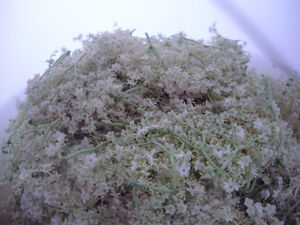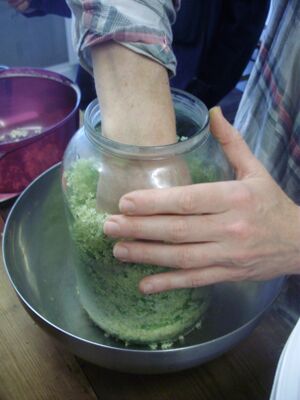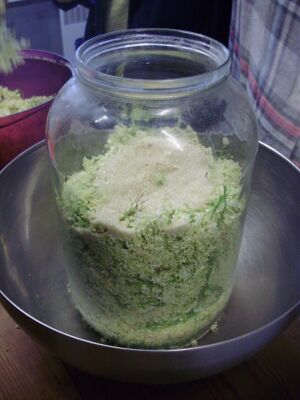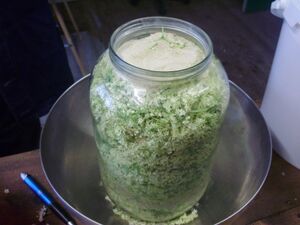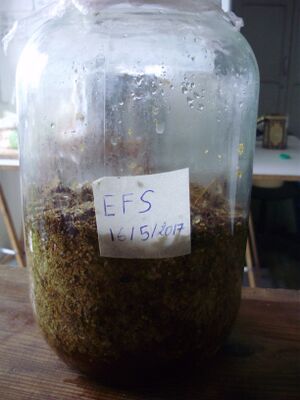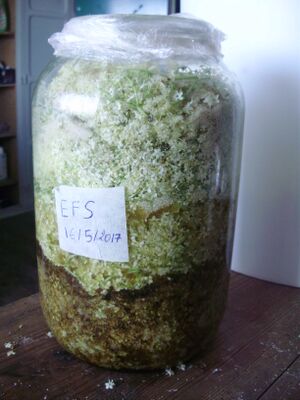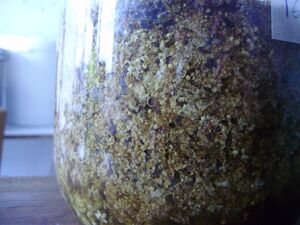Recipe:Elderflower syrup
Manual for making elderflower syrup
The procedure described below allows you to make cold style elderflower syrup just from flowers and sugar, no water or other ingredients added. There are few things which I recommend to keep in mind. You should not harvest the flower after the rain, doing it after one day of dry weather more is better, the rain takes out part of the flavour. Do cut out green parts, stalks, of the flowers they have off flavour but be efficient, you should be able to produce around two kilos of cleaned flowers per hour of work. Do seal the jar where the syrup is made so no air enters because it can cause oxidation which you can see by change of colour but most of all if not sealed properly the mold is close to certain to contaminate. The jar should allow for bit of gas to be released so it doesn't explode, "swing top" jars with rubber seal work great. The original ratio is 1:1 sugar to flower but you can play with it one way or other.
Manual
- harvest elderflower flowers on a non rainy day, if possible one day or two days after heave rain
- 3-4 kg of flower per hour in the season is doable, it comes handy to have a stick with hook on one end and some string on the other end, like that you can be much more efficient. Lower the branches and by using your feet by stepping down on the string you can harvest the flowers by both hands. I use good scissors and wide bucket so I can throw the flowers in directly.
- when processing, cut off the stalks because they have off flavour and keep just the blossoms, most of the time one or two cuts per flower is enough
- the ingredients are in 1:1 weight ratio. For example for 3 l jar I recommend to weight out 200 g of flowers, make a layer from them in the jar and cover them equally with 200 g of sugar, biologic one if you can, light brown. After that make another layer of elderflower and sugar keeping to the ratio. I highly recommend to write down the amounts which you use and label the jar.
- the last layer should be of the sugar so it prevents the flowers from getting moldy. It may be more efficient to change the weight of the last layer because it may not fit or just little would rest, just keep to the ratio. Close the jar properly and let sit at ambient temperature, 10-25°C is fine, it can be even more or less.
- within few days the flower and sugar mix will settle, you will see the sugar to dissolve in the liquid from the flowers. There will be then place left in the jar. Add again flowers and sugar keeping to the ratio and close properly. You may do this two or three times to use the place efficiently and to keep the volume of air in the jar at minimum. Be careful not to add too much because it can run out when the slow fermentation starts.
- let the jar to sit for weeks, months or even year or two, you can experiment here. Keep in mind that the liquid will ferment at some certain manner, not sure which fermentation takes place in really, however it will make gas which needs to be able to escape.
- when you decide to squeeze out the syrup use small press or your hands. There will be decent amount of syrup left in the flowers so you may consider to macerate it in alcohol for example or some other solution to make the yield higher.
- strain the syrup through some sieve and bottle it. Keep in mind that it takes months or even a year before the syrup stops fermenting, it can get very highly carbonated and the bottle can definitely explode if the gas can not escape.
- before serving mix the syrup a bit, the layer on the bottom are generally the pollen grains
- enjoy!
- PS You can use this technique and ratio with many other fruits or blossoms, I learned it in Korea by making the traditional meshil (매실).
